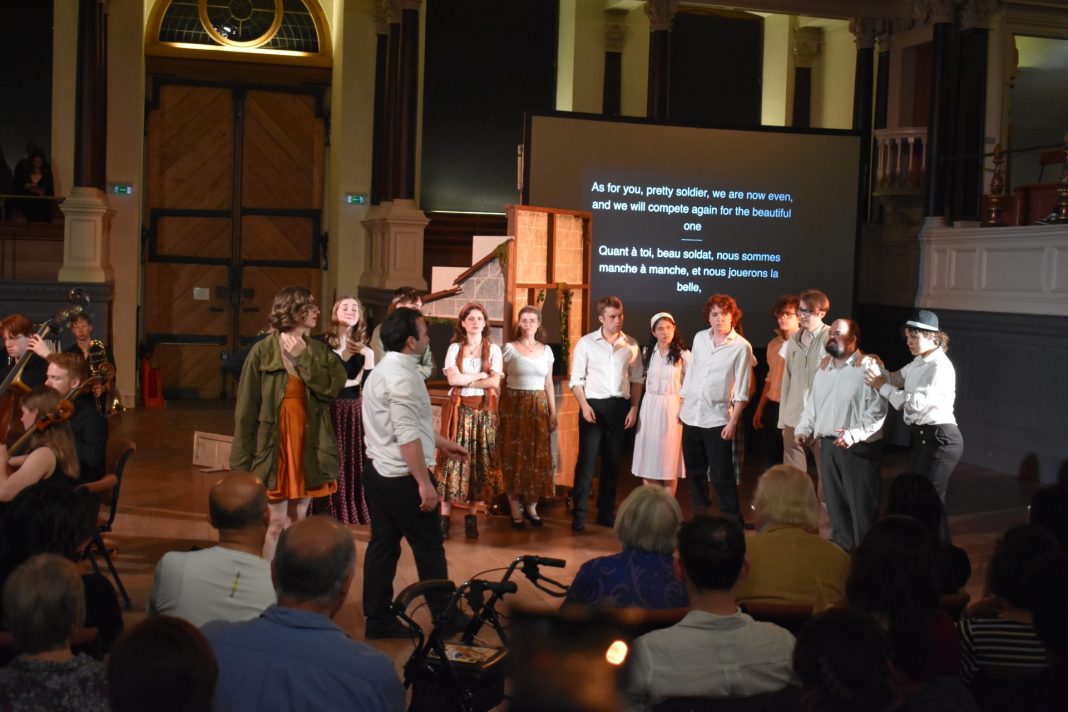If you recall Pixar’s UP, a comedy where an old man balloons with his dog to South America, a funny moment appears in Carl’s morning routine: the agonizingly slow stairlift in his house. What makes this scene funny is the tune we hear, all its tension, frustration, and sauciness – and that tune comes from Carmen.
Set in southern Spain, the opera follows a Gitano woman, Carmen (Milete Gillow), and her complex relationships with two men, the soldier Don José (Robin Whitehouse) and Escamillo (David Biccaregui) the bullfighter. Unable to handle Carmen’s rejection, Don José murders her at the very end, just before Escamillo enters the bullring. The Oxford Opera Society’s Friday night performance of the opera in the Sheldonian gave us an entertaining performance, looking past a few musical and logistical issues, but their faithful approach to Carmen’s problematic stereotypes raised questions about producers’ responsibilities today.
There were certainly many laudable moments; one of our personal favourites was the incorporation of dance into a number of scenes. Elizabeth Lee, Lilly Law, and Rosie East delighted us with graceful twists and turns in nostalgic ‘character dance’ skirts, reminiscent of primary school ballet. The fight scene between Don José and Escamillo was also enjoyable, with impressively slick flips and glanced blows.
The soloists certainly had their moments too. Act 1’s ‘Habanera’ was particularly captivating, as Carmen taunted infatuated soldiers with vocal portamento and her commanding stage presence. In Act 3, we heard Michaëla (Lucy Elston) pleading with her aria ‘Je dis que rien’, accompanied beautifully by Tommaso Rusconi on horn. Carmen’s hit tunes drew generous applause between numbers.
Although peppered by scintillating musical talent, the opera did leave much to be desired. Starting with some practical issues, the orchestra seemed thin on the ground for string players, blasted out by trombones in the ‘Overture’. At times the players seemed completely lost, such as during the tra-la-la flute number, or the offstage brass in the finale (half a beat behind). Our stellar singers were missing some key structural support from the orchestra, dragged along by rather pompous conducting. Carmen may be an opéra comique, but its passionate arias may have benefited from a little more flexibility.
Staging and lighting choices were equally confusing. A multipurpose minimalist set was awkwardly moved around for each new scene, with a couple of screws going missing in the process. Lighting was stark and abrupt – who wants mustard yellow for a love scene?
To be fair, a seventeenth-century theatre is no ideal substitute for a modern opera house, with all its technical riggings. And don’t get us wrong: we were definitely entertained. Some of the production’s best moments came from its ingenious use of props to focus on key moments. The addition of tequila shots during the party scene was a modernising and fun addition. Carmen’s impressive castanet skills while she flirted with Don José helped draw us into the scene’s sexual tension.
But overall, the heart of Carmen seemed to have been missed. Carmen’s journey from commanding and powerful to objectified, used, and ultimately murdered, could have been a perfect platform to address issues of sexualisation and violence against women. Instead of critically engaging with the opera’s bullring of nineteenth century attitudes, Oxford Opera Society preferred to recreate them.
Take the production’s costuming, for example. Carmen’s transitions from yellow to red foreshadow the act of her murder and remind the audience of the violence to be committed against her. Carmen’s sexual liberation is her undoing, prophesied by fortune cards, and we are left with the message that unruly femininity kills. Compare this with Michaëla in her old-fashioned blue dress: Michaëla is the ‘ideal’ domestic feminine, the ‘right’ woman for Don José as she pleads him to return home in Act 3, but José is led astray by the unruly Carmen. The duality between the two women, at least in this production, seemed to align the audience with Michaëla, and condemn the dangers of women’s freedom and empowerment that Carmen represented.
Opera is a product of its time. Bizet’s Carmen reflects a misogynist, racist Third Republic France fantasising over Spanish and Gitano women whilst condemning resistance to the status quo. Why should today’s productions toe the line? Carrie Cracknell at the Met, or Johan Inger at the English National Ballet have reimagined Carmen in innovative and empowering ways, profiling the story’s darker themes. Perhaps the Oxford Opera Society should reconsider their fidelity to the score and embrace the task of interpretation in our uncertain times. Only then might they more earnestly enter the bullring of Carmen.


